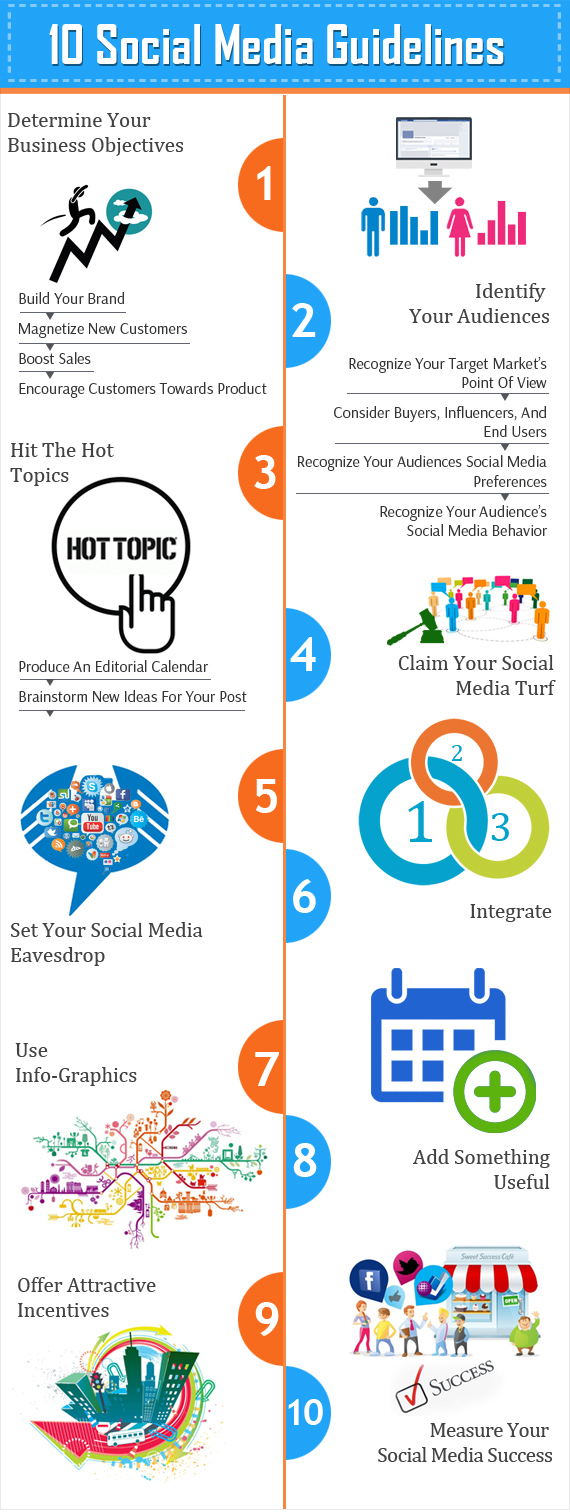10 Social Media Guidelines for Improving Bottom Line Strategy
Recently updated: April 1st, 2020

There are many questions that come to mind when you heard “Social Media Guidelines”. What are social media guidelines? Why are they essential for a business? Why would a company needs social media guidelines? These are some of the important questions that will be answered in the blog so read cautiously below.
These social media guidelines are especially designed to assist you in making responsible decisions when posting, creating or else contributing to blogs, social networks, virtual worlds, wikis, or other social media. Whether you log in to either using social media platforms such as Facebook, Twitter, LinkedIn, YouTube, Google+, Yelp, MySpace, Instagram, Wikipedia, Pinterest or any form of digital media, these guidelines are very beneficial to your business.
Today, more or less every business and employees are participating in Social Media, so it becomes very important for those who are “noobs” to understand and follow some simple yet essential guidelines that are mentioned below:
1. Determine your business objectives
One of the most important guidelines is to determine the goal of your business. How would you want to use social media to help your business? What goals would you target? These are some important questions that you need to make clear. Try to simplify your goals as concrete, measurable and achievable as possible. Some common objectives that often adopted by businesses that are mentioned below:
- Build your brand:– Make people recognize your brand’s name and associate themselves to your products or services.
- Magnetize new customers:– Put something attractive and useful to your customers on social media page or company website.
- Boost sales:– Answer your customer’s queries and tell them about how to use your products or services.
- Encourage customers towards product:– Give customer a reason to talk about your brand and also encourage others to buy your product.
2. Identify your audiences
Create a set of marketing characters for the selective segments that you want to achieve.
- Recognize your target market’s point of view:– Make a graph of demographics, psychographics and past purchases and also interests and priorities.
- Consider buyers, influencers, and end users:– Most of the purchase decisions are made with the effort of team.
- Recognize your audiences social media preferences:– It is not necessary that everyone uses same social media.
- Recognize your audience’s social media behavior:– Understand about the customer’s behavior by sharing or creating social media content.
Do you just want a “like” on Facebook or do you want make your fans your customers? Think about it.
3. Hit the hot topics
Target hot topics and these should be in words that can be placed in the search optimization.
- Produce an editorial calendar that is integrated with your promotional calendar. Develop a framework in order to minimize content creation time so that you can avoid thinking about the content before crafting your content.
- Brainstorm new ideas for your post around keywords. Before writing your content list, emphasize on the main topics that you want to cover.
4. Claim your social media turf
Create a presence of your brand on all major social media platforms, even if you don’t have a social media plan as a backup. Take ownership of your brand’s name across all social media platforms. Secure your brand’s name for the main social media profiles as branding is a shorthand that helps customers to identify your company without thinking.
5. Set your social media Eavesdrop
Three main tools that come to mind for eavesdropping are Google Alerts, brand’s Facebook page and Twitter searches. Just listen to what people are saying about your brand or business on social media.
6. Integrate
Tell your customers about what social media platforms you are sharing. Simply put your social medial profile on your business cards, invoices, websites, emails, stationery, newspaper ads and in your window. In case, you are using more than one social media platform, just link to them from your website and the other social media platforms you are using.
7. Use Info-Graphics
Most of the people like photos attract them by inserting pictures of your products, employees, your clients, your customers, and office pictures.
8. Add something useful
Make your customer’s day by adding useful things, special offers and something that can attract them. Tell them what they can use and how to use your product in a daily basis.
9. Offer attractive Incentives
In order to make your customers follow you on the social media platforms, offer attractive incentives. For instance, if they like you on Facebook, they will get a special coupon from your company.
10. Measure your social media success
Make sure that you can track your actions that have taken place on social media platforms. It will be totally based upon your business objectives. Incorporate a social media call to action and track indicators that shows the accomplishment of your objectives.
Above mentioned guidelines can ease novice’s fears and assist them in every step.
Bottom line
Businesses can successfully use social media in order to achieve your business objectives. Plan ahead to make sure that your time spent on social media emphasizes your other business messaging and yields measurable results. The above guidelines will surely help you in improving the standard of your business.
Latest posts by Vijaya Tyagi (see all)
How To Track Shopify SEO Performance & Metrics (2025) - January 14, 2025
Link Building Strategies: The Ultimate Techniques for 2025 - December 31, 2024

